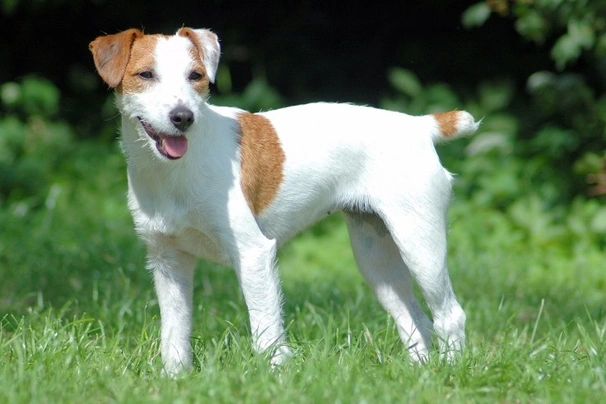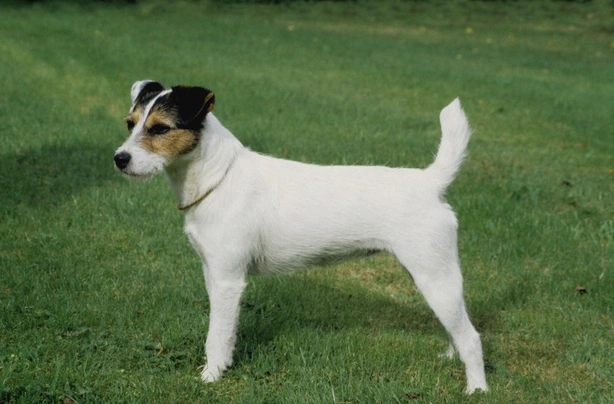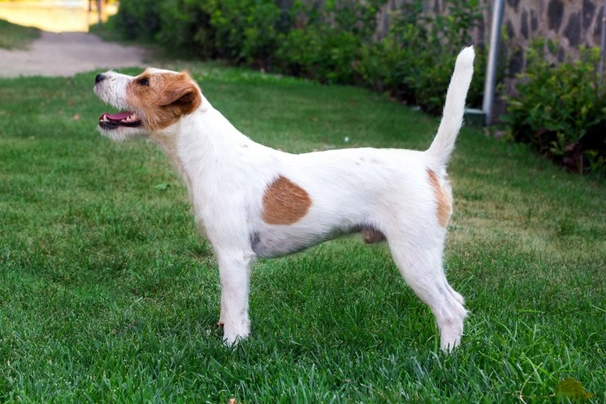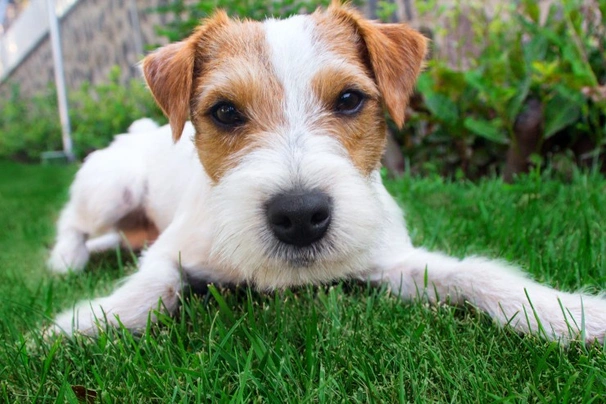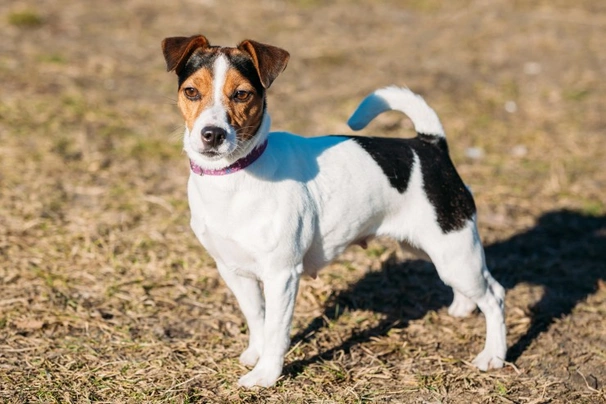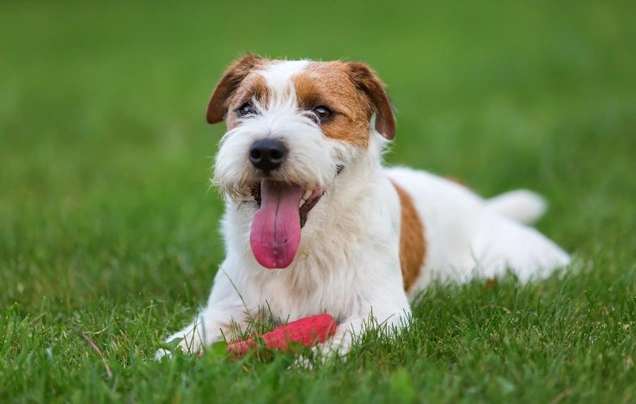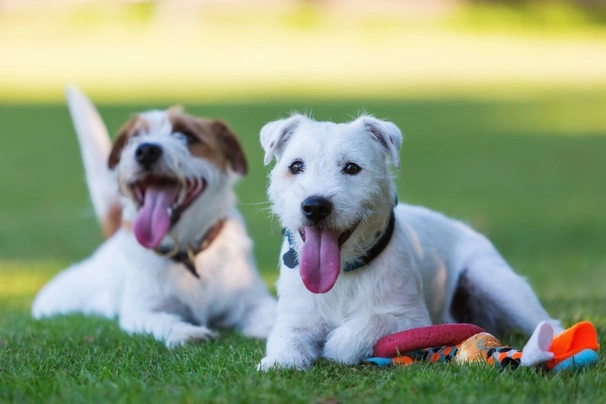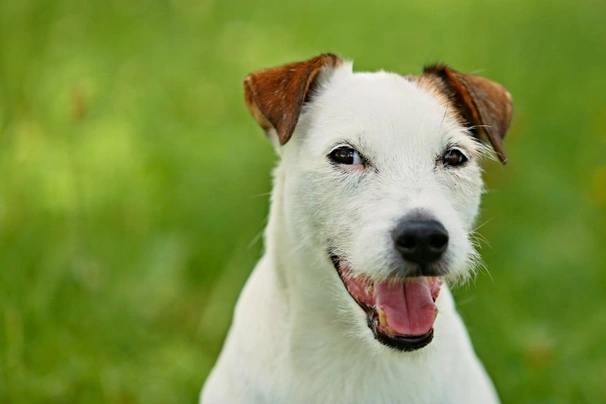Parson Russell Terrier
Pros
Cons
Introduction of the Parson Russell Terrier
The Parson Russell Terrier is a lively, intelligent and versatile terrier breed originally bred in the UK to work alongside Foxhounds in hunting foxes, sporting exceptional stamina and agility. Today, this breed has transitioned gracefully into the role of a cherished family pet and energetic companion, renowned for their keen alertness and boundless enthusiasm for outdoor activities that engage their natural chasing instincts.
Physically compact yet muscular, the Parson Russell Terrier combines an athletic build with a spirited temperament, making them perfect for active owners who enjoy rural environments or homes with secure gardens. They possess either smooth or rough coats, both dense and weather-resistant, perfectly suited to their working heritage. Intelligent and quick to learn, these terriers exhibit a loving and loyal nature, though they require ample mental and physical stimulation to thrive.
Ideal owners of Parson Russell Terriers tend to be highly active individuals or families with a lifestyle that includes regular outdoor exercise and interactive play. Their high energy levels and natural hunting drive mean they are best suited to homes that can provide opportunities for scent work, agility, or off-lead running in safe spaces. Apartment living or sedentary lifestyles are generally unsuitable for this breed without a careful and committed exercise routine.
Care for the Parson Russell Terrier involves consistent training, secure containment due to their expert digging and escape skills, and regular grooming to maintain their distinctive coats. Owners must be committed to providing both structure and companionship to prevent behavioural issues stemming from boredom or separation. With the right environment and care, they become affectionate, entertaining, and undemanding companions who bring considerable joy and vitality to their families.
Perfect For
Active families or individuals with ample time and space to provide daily vigorous exercise and mental stimulation, working dog enthusiasts, and those seeking a small yet agile and fiercely intelligent terrier companion.
Key Considerations
The breed's strong prey drive demands vigilant control in open environments; they require secure fencing and careful supervision. High exercise needs and mental challenge are critical to prevent destructive behaviours. The expert digging and escape capabilities present a challenge for containment. Early socialisation and ongoing training are essential to manage their spirited and sometimes mischievous behaviours.
History of the Parson Russell Terrier
The Parson Russell Terrier traces its origins to the early 19th century in England, developed by the Reverend John "Jack" Russell, a keen fox hunter determined to breed a terrier that could keep pace with Foxhounds and flush foxes from their dens without killing them. This selective breeding began after Russell acquired a remarkable female terrier named "Trump" around 1818 in Oxford, marking the foundation of what would become the Parson Russell Terrier lineage.
Early Development
The foundation dogs were descendants of "foxing terriers" from the 18th century, though formal records only began from 1862. Early breeding goals focused on producing terriers with a balanced conformation: sturdy bone, moderate legs, and a lively disposition, capable of working efficiently alongside hunters. Reverend Russell's breeding programme emphasized agility, stamina, and a keen hunting instinct without excessive aggression, setting the breed apart from other contemporary terriers.
In 1875, the Fox Terrier Club was established with Russell as a founding member, setting breed standards aimed at preserving his vision. While the Fox Terrier evolved nationally, some older types persisted in remote British regions; these formed the genetic base for the Parson Russell Terrier. After Russell’s death, the Parson Jack Russell Terrier Club was established, gaining official Kennel Club recognition in 1990 as a variant of the Fox Terrier, and the breed was renamed the Parson Russell Terrier in 1999.
Modern Recognition
Since its recognition, the Parson Russell Terrier has grown in popularity both as a working dog and companion, valued for its exuberant temperament, intelligence, and versatility. The breed club continues to monitor and support health and temperament standards, ensuring the Parson Russell retains its characteristic traits and functional abilities. Its hunting heritage is still evident, but it also excels in canine sports such as agility and therapy work, with the breed ranking steadily among popular UK terriers today.
Appearance of the Parson Russell Terrier
Size and Build
The Parson Russell Terrier is a small, compact dog exhibiting athletic build and balance. Males typically stand between 36 to 36 cm tall at the withers, while females measure slightly smaller, around 33 to 33 cm. Weights are consistent across sexes, ranging from 5 to 8 kg. Their bodies are well-proportioned, with deep chests, strong backs, and muscular limbs providing power and flexibility, essential for their working roles. Slightly arched loins and a straight strong back support a poised and agile stance.
Coat and Colours
Coat varieties include both rough and smooth-faced types; both have dense, close-lying, coarse-textured outer coats with a thick protective undercoat well suited for all-weather working conditions. Traditional coat colours accepted by the Kennel Club comprise a range of combinations including black & white, lemon & white, tan & white, tricolour, and solid white. Markings may vary but all conform to the breed’s standard colouring guidelines, contributing to their distinctive appearance.
Distinctive Features
The head is wedge-shaped with a moderately broad, flat skull tapering toward almond-shaped dark eyes exuding intelligence and alertness. The ears are V-shaped, proportionate, and drop forward with tips reaching the eyes’ corners, enhancing expression. A black nose and a powerful jaw with a perfect scissor bite are breed hallmarks. Their feet are compact with arched toes and firm pads, supporting their agility. Tails set moderately high taper and are carried high when alert or lowered at rest, completing the balanced overall silhouette.
Gender Differences
Males are marginally taller and more robust, reflecting slightly more muscle mass, although temperamentally both sexes share lively, energetic, and playful characteristics. There is no significant behavioural divergence, though individual personality variations occur as with any breed.
Temperament of the Parson Russell Terrier
Core Personality Traits
Parson Russell Terriers are spirited, lively, and remarkably intelligent dogs with a strong desire to please their owners. They thrive on daily physical activity paired with mental challenges to maintain a well-rounded, obedient demeanour. Their alertness and inquisitive nature make them excellent watchdogs, while their affectionate side shines strongly with family members.
Social Behavior
This breed forms close bonds with their humans, preferring company and often struggling with being left alone, which can lead to separation anxiety and destructive behaviours if unstimulated. They are generally friendly with people, including children particularly when raised together, but their high prey drive necessitates caution around small pets and vigilant socialisation to ensure harmonious interactions with other dogs. Their tendency to bark alerts owners rather than display aggression, usually maintaining a respectful distance from strangers.
Working Instincts
Parson Russells retain sharp hunting instincts, exhibiting a high prey drive and enthusiasm for scent and chase activities. Their agility and tenacity are unmatched, underpinning their legacy as foxing terriers. This drive requires regular channelled exercise to prevent boredom-induced behaviours such as excessive barking or digging, which owners must be prepared to manage.
Common Behavioral Challenges
Without sufficient exercise and engagement, Parson Russells may develop problematic behaviours including persistent barking, digging, and escape attempts. Their high energy and low boredom threshold demand a commitment to daily structured activity and training. Owners must set consistent boundaries to manage their clever, sometimes mischievous tendencies effectively. While generally good with older children, they may be less suitable for homes with very young children due to their exuberant play style.
Intelligence / Trainability of the Parson Russell Terrier
The Parson Russell Terrier responds exceptionally well to training when it is consistent, positive, and engaging. Their intelligence and eagerness to please make them quick learners, but their independent streak means they can become bored or distracted without varied and motivating training sessions. Early socialisation and ongoing behavioural training are crucial to channel their energy and minimize unwanted behaviours such as excessive barking or selective hearing.
Puppy Training Priorities
From the moment puppies are fully vaccinated, early exposure to diverse people, environments, and other animals is critical. This socialisation helps reduce potential fear or aggression later in life. Basic commands such as come, sit, stay, quiet, leave it, down, and bed should be introduced gently but firmly to establish clear communication and pack position.
Training Methods That Work
Positive reinforcement using treats, praise, or play motivates Parson Russells more effectively than harsh corrections. Short but frequent training sessions keep their attention while providing the mental stimulation they crave. Activities such as agility courses harness their athleticism and enthusiasm, improving responsiveness and focus.
Advanced Training Potential
These terriers excel in canine sports including agility, flyball, and obedience competitions. Their mental sharpness and physicality also allow them to perform specialised working roles, such as therapy visits, which utilise their friendly and affectionate natures. Ongoing challenges keep them engaged and happy.
Common Training Mistakes
Overindulgence in puppyhood can lead to behavioural problems; early boundary-setting is vital. Ignoring their need for mental exertion often results in destructiveness. Inconsistent commands or negative reinforcement can cause confusion or fearful responses. Owners are advised to maintain patience, clear communication, and engagement to foster well-adjusted adults.
Children and other
Age-Specific Interactions
The Parson Russell Terrier interacts best with children who are old enough to understand how to engage safely and respectfully with a spirited terrier. With toddlers and very young children, supervised interactions are critical to prevent accidental knocks or overstimulation due to the dog’s energetic play style. Older children and teenagers tend to enjoy the breed’s lively personality and are generally capable of managing their boldness effectively.
Teaching Children Proper Interaction
Children should be taught boundaries such as not disturbing the dog when eating or resting, using gentle handling, and recognising signs of overstimulation or stress. Demonstrating calm, firm, and respectful behaviour encourages positive exchanges and fosters a lifelong bond between child and dog.
Breed-Specific Considerations
Due to their small size but high energy and sometimes boisterous nature, Parson Russell Terriers may inadvertently be too rough for very young or timid children. Their high prey drive also requires vigilance with smaller pets and encourages responsible management when the dog is playing or interacting indoors and outdoors.
Creating Safe Environments
Supervision is essential during all interactions to ensure safety and comfort for both children and the dog. Providing a quiet retreat or safe space for the dog to withdraw to when overwhelmed reduces stress. Families should establish consistent routines and rules to manage playtimes and prevent misunderstandings or overly rough behaviour.
Health of the Parson Russell Terrier
Breed-Specific Health Conditions
Renowned for their robustness, Parson Russell Terriers boast an average lifespan of between 9 and 15 years when maintained on a healthy diet and proper veterinary care. Their designation as a Category One breed on the Kennel Club Breed Watch Scheme affirms a low profile for prevalent health issues. Despite this, breed-specific concerns remain, notably hereditary deafness, primary lens luxation (PLL), late onset ataxia (LOA), spinocerebellar ataxia (SCA), and hyperuricosuria (HUU)/urate stones, all of which have accessible DNA tests sponsored by the Animal Health Trust.
Genetic Testing Requirements
These genetic tests are integral to responsible breeding protocols, preventing the propagation of inheritable diseases. The British Veterinary Association's eye scheme complements genetic testing by regularly monitoring eye health across breeding stock. BAER tests, particularly for white-coated dogs prone to deafness, are strongly recommended.
Preventive Healthcare Schedule
Standard vaccination schedules commence at 10 to 12 weeks old, with follow-ups as guided by veterinary experts. Worming, flea, and tick prevention are critical year-round. Neutering, typically advised between 6 to 12 months, depends on veterinary advice and should be timed to support optimal health and behaviour outcomes.
Insurance Considerations
With moderate insurance costs reflective of their generally healthy status, Parson Russells should be covered for routine care, accidental injury, and possible hereditary conditions. Comprehensive plans are recommended due to the breed’s active lifestyle and potential for injury during vigorous exercise.
Caring for the Parson Russell Terrier
Daily Care Routine
Daily care for a Parson Russell Terrier involves structured physical exercise, mental engagement, and routine grooming. Morning activities might include a short walk, followed by interactive training or play sessions, with a longer, stimulating afternoon walk to expend remaining energy. Regular grooming, dental care, and ear inspections keep the dog comfortable and healthy.
Living Environment Needs
Secure living environments with fenced gardens prevent escape and provide safe exercise space. Given their digger nature and escape artistry skills, owners must regularly inspect fencing. While adaptable to apartments if adequately exercised, Parson Russell Terriers prefer country or rural-like settings where they can capitalise on their hunting and exploring instincts.
Seasonal Care Adjustments
Heat management in summer includes ensuring shade and hydration, avoiding excessive exercise during peak temperatures. In colder months, thickening of coats necessitates drying and protection from dampness. Seasonal shedding around spring and autumn demands increased grooming attention to maintain coat condition and avoid matting.
Senior Care Adaptations
As they age, adjustments in diet, exercise routines, and healthcare needs are essential. Older dogs benefit from softer bedding, joint supplements, and low-impact activities to support mobility. Monitoring for common senior conditions such as arthritis and sensory declines enables timely intervention to sustain quality of life.
Grooming of the Parson Russell Terrier
Coat Maintenance Schedule
Parson Russell Terriers possess a double coat which requires different grooming regimes depending on coat type. Smooth-coated individuals need brushing once weekly to manage shedding and maintain healthy skin. Rough-coated dogs require more dedicated care, including seasonal hand stripping every 3 to 4 months to remove dead hair and preserve coat texture.
Professional Grooming Requirements
Hand stripping for the rough coat is usually performed by professional groomers and costs approximately a340 to a360 per session. Smooth coats rarely require professional grooming beyond nail trimming and ear cleaning. Regular care in between professional visits is necessary to keep coats in top condition.
Home Grooming Techniques
Owners should use slicker or soft bristle brushes to detangle and remove loose hairs. Ear inspections and cleaning weekly prevent infections, and nail clipping is essential to avoid discomfort. Using dog-specific toothpaste and toothbrushes maintains oral health effectively at home.
Common Grooming Challenges
Challenges include preventing matting in rough coats without timely stripping and managing increased shedding during seasonal changes. Skin allergies or irritations require veterinary attention. Ear infections are common if wax or debris accumulates, so regular ear care is vital.
Exercise of the Parson Russell Terrier
Daily Exercise Requirements
The high energy Parson Russell Terrier needs at least 60 minutes, ideally up to 90 minutes, of vigorous daily exercise. This should include a mix of walks, play, and off-lead activities within secure areas to channel their natural instincts productively. Pacing exercise throughout the day helps manage energy and prevent boredom.
Suitable Activities
Agility, flyball, scent work, and interactive games suit their athleticism and keen intellect. Swimming may be enjoyed by some, though this varies individually. Variety is key to engagement, preventing the development of destructive or restless behaviours.
Exercise Restrictions
Puppies require careful exercise moderation to avoid damage to growth plates and joints; jumping, running on hard surfaces, and stairs should be limited until maturity at around one year. Weather extremes also necessitate exercise adjustments for health safety.
Mental Stimulation Ideas
Incorporate puzzle toys, obedience challenges, scent tracking, and interactive training games to satisfy the breed’s high mental energy. These activities complement physical exertion and support psychological wellbeing.
Feeding of the Parson Russell Terrier
Nutritional Requirements
Parson Russell Terriers require a nutrient-dense diet supporting high activity and lean musculature, with protein levels between 14-21% and fat content under 10%. Feeding should accommodate life stage changes from growing puppies to adults and seniors.
Feeding Schedule Guidelines
Puppies thrive on 3-4 meals per day, gradually transitioning to two meals as adults. Portion sizes depend on body weight and individual metabolism; careful measurement helps prevent obesity. Treats should be given sparingly and factored into the overall diet.
Special Dietary Considerations
The breed may be sensitive to fillers and certain allergens; gradual food introductions help identify intolerances. Supplements like omega-3 fatty acids may support joint and coat health. Grain-free or limited ingredient diets may benefit dogs with allergies.
Weight Management
Regular weight monitoring is critical to prevent obesity, which can affect longevity and joint health. Adjust food intake and exercise level accordingly, noting any weight fluctuations at ageing stages.
Parson Russell Terrier price
Purchasing a well-bred Parson Russell Terrier puppy in the UK typically ranges between a3600 and a31100 when sourced from reputable individual breeders, with licensed breeders potentially pricing at the higher end due to health screening and pedigree documentation. Prices may vary slightly according to pedigree quality, coat type, and breeder reputation.
Initial setup costs include essentials such as quality dog beds, feeding bowls, collars and leads, grooming tools, toys, and a secure crate, averaging around a3100 to a3150. Good quality dog food tailored to their life stage averages between a320 to a330 per month. Veterinary costs, including vaccination, neutering/spaying, and annual health checks, typically amount to over a3800 annually, factoring in insurance and occasional treatments.
Insurance premiums for a 3-year-old Parson Russell Terrier can range from about a320 to a340 per month depending on coverage level and location within the UK, with northern England premiums typically lower within that bracket. Grooming costs vary depending on coat type, with rough-coated dogs requiring occasional professional hand stripping costing a340 to a360 every few months, while smooth-coated dogs have minimal grooming expenses.
Overall, the monthly maintenance cost for a Parson Russell Terrier can be expected between a350 and a370, excluding the initial puppy purchase. Budgeting for ongoing health care, quality nutrition, exercise needs, and grooming ensures a happy and healthy life for this energetic breed.
To browse available Parson Russell Terrier puppies and dogs for sale, you can visit find Parson Russell Terrier for sale on Pets4Homes.
Buying advice
When seeking a Parson Russell Terrier puppy, prospective owners must prioritise ethical breeding to ensure the health and temperament of their future companion. Prices from reputable breeders range broadly from a3600 to a31100, reflecting health screening rigor, pedigree quality, and breeder reputation. Beware of offers significantly below market value to avoid scams or irresponsible breeding.
Visit breeders in person to check living conditions, meet parents, and observe puppies' socialisation levels. Confirm appropriate vaccinations, microchipping, worming, and documentation conforming to Kennel Club assurances.
Finding Ethical Breeders
Choose breeders registered with the Kennel Club Assured Breeder Scheme who perform comprehensive DNA health testing, monitor breeding stock regularly, and focus on temperament and socialisation from an early age. Ask about litter sizes, health results, and references.
Health Testing Verification
Inspect certificates for genetic tests for Primary Lens Luxation (PLL), Late Onset Ataxia (LOA), Spinocerebellar Ataxia (SCA), Urate Stones (HUU), as well as BAER hearing and eye testing. These confirm responsible breeding practices.
Puppy Selection Process
Choose puppies displaying balanced temperaments—neither overly shy nor aggressive. Engage breeders in discussing health histories and any breed-specific behaviours. Aim for well-socialised, confident pups.
Contract and Guarantee Review
Reputable breeders provide clear contracts detailing health guarantees, refund or return policies, and continued support. Carefully scrutinise terms before purchase, questioning any ambiguities or pressure tactics.
Rescue and Adoption Options
Consider rehoming through Parson Russell Terrier-specific rescues or local shelters where suitable adults or young dogs may be waiting, offering a valuable alternative to purchasing.
Visit find Parson Russell Terrier for sale to view current listings and connect with ethical breeders and rescues in the UK.
